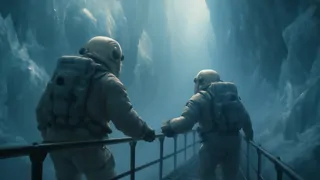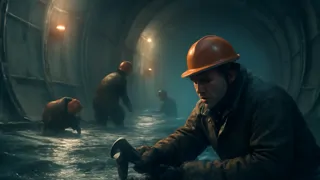Introduction
The first time Dr. Lena Ortiz stepped out onto the landing platform of the Ganymede Research Station, she felt as though she had entered an impossible dream. The platform, carved directly from fractured ice that glowed pale blue beneath her boots, stretched toward a yawning fissure where twin heat vents cast swirling tendrils of mist into the thin Jovian sky. Above her, Jupiter hung like a shattered globe, its belts glowing in violent crescendos of ochre and cream, as if the storm giant itself watched her approach. At the far edge of the platform, the modular habitat domes shimmered like pearls under the station’s floodlights, their surfaces etched with frost and long opaque windows that seemed to peer back into her soul. The airlock hissed its welcome, a reminder that outside, Ganymede’s gravity pressed her down with only one seventh of Earth’s comforting pull, and that every inhale was a marvel of human engineering. She paused at the threshold, heart pounding, and reflected on the journey that had carried her two billion miles from home: the rocket’s roar, the weeks of weightlessness, the rigorous preparation drills, and the shared excitement and tension of every crew member. Now, gazing at the dark ridge where the ice shelf plummeted into the unknown depths, she felt a stir of awe stronger than any she’d known on Earth. This was a world of brute extremes and fragile hope, where scientific ambition danced atop a frozen sea that might harbor life in its unseen currents. As the airlock door sealed behind her with a final clank, Lena took a steadying breath, braced herself, and stepped into the heart of the station, ready to become both guest and explorer in a realm beyond imagination.
Into the Frozen Depths
Dr. Lena Ortiz’s first mission beyond the habitat walls was to descend into the ice fissure at Echo Gorge, a narrow trench rumored to lead directly to the subglacial ocean that had become the station’s greatest scientific prize. She and her team followed a spiraling stairway cut into the sheer ice wall, every step filling their boots with the crisp echo of isolation. Their headlamps pierced swirling clouds of vapor, illuminating crystalline growths of ice that resembled alien corals. Two kilometers below, the passage opened onto a cavernous chamber where geothermal vents cast pools of warm brine that steamed against the frozen ceiling. Lena knelt at the water’s edge, heart thrumming, and dipped a sensor probe into the inky liquid. Readings flickered across her helmet display—unexpected chemical signatures that hinted at complex organic molecules.

This discovery sent ripples of excitement through the station. Back in Laboratory Alpha, the team worked around the clock, analyzing samples under pressure-controlled habitats designed to replicate Ganymede’s depths. Lena’s hands moved with precision beneath the microscope, tracing cell-like structures that pulsed with minute energy fluctuations. The possibility of extraterrestrial life brought the station to a fever pitch: comms channels buzzed with new protocols, safety drills were revised, and the hydroponic gardens, once dedicated to food production, were repurposed to cultivate microbes under strict quarantine.
Despite the triumph, tension grew. The station’s power converters strained to maintain heat and light against the bitter cold. A sudden storm in the exosphere sent radiation spikes that forced the crew into deep shelters for hours. In the cramped corridors, nerves frayed and whispers of doubt echoed: Was it worth risking everything for organisms no larger than a grain of sand? Through it all, Lena remained resolute. She saw in those tiny structures a testament to life’s tenacity, a message from the universe that hope could tremble in the smallest of forms.
When the final data came in confirming active biochemical cycles, the team erupted in cheers that rattled the lab’s steel hull. Lena stood among them, tears tracing paths down her frost-clad cheeks. In that moment, under the pale glow of station lights and the ever-watchful eye of Jupiter overhead, she felt the weight of human perseverance—mankind’s unyielding urge to challenge the void and discover its secrets.
Life Beneath the Shell
With proof of metabolic activity in the brine samples, Dr. Ortiz prepared a bold second expedition: an underwater dive into Ganymede’s dark sea. The station’s submersible, nicknamed the Nautilus II, was designed to withstand four hundred atmospheres of pressure. Its transparent alloy viewport would offer a first-ever glimpse of the alien horizon beneath the ice. In the launch bay, Lena ran through checklists as the Nautilus II glowed beneath overhead floodlights. The hatch sealed with a hiss, and with a soft jolt, the vessel slipped beneath the ice, water enveloping it in a near-silent embrace.

Through the viewport, Lena watched strange bioluminescent tendrils snake through the darkness, pulsing in fractal rhythms that defied any Earth analog. The sonar mapped vast plateaus of jagged mineral formations, towering hydrothermal vents emitting heated plumes that swirled into inky curtains. At one point, the submersible’s lights revealed a sudden flicker—a darting shape the size of a manta ray, its wing-like fins rippling with phosphorescent filaments. Lena pressed her gloved palm to the viewport, breath caught in wonder as the creature arced around the Nautilus II, pausing only for the briefest curiosity before vanishing into the gloom.
The dive lasted four hours, but to Lena it felt like a lifetime suspended between awe and dread. Every system blinked green except for a creeping temperature drop along the hull—an ice shard had scratched the exterior panel, threatening to crack under the ocean’s pressure. Communications flickered, and Lena initiated an emergency ascent. The Nautilus II’s ascent motors hummed, and the craft rose through the freezing water until it breached the ice shell and slid back into the launch bay. As the bay doors closed, Lena’s team celebrated the footage they’d collected—proof that Ganymede’s ocean harbored a thriving ecosystem. Yet beneath the elation lay a sobering truth: the station was vulnerable, and the ocean’s depths harbored mysteries that could reshape humanity’s understanding of life.
Back in the control room, Lena watched live feeds of the ice shelf as Jupiter’s magnetosphere danced overhead. The station’s sensors recorded microquakes and radiation surges, each anomaly a reminder that this world was alive in its own harsh way. Supplies would dwindle, hull fatigue would mount, and rescue, if needed, lay years away. But when she closed her eyes that night, it was not fear that filled her dreams—it was wonder. In the stillness of space, under layers of frozen crust, she had gazed upon the spark of alien life, and in that moment she knew that every risk had been worth the discovery.
The Edge of Survival
In the weeks that followed, the station thrummed with urgency. Supply runs from Earth were months away, and the hull’s integrity wavered under shifting ice pressures. When a sudden quake ruptured a power conduit in the western wing, half the station plunged into darkness. Mechanical alarms blared, and emergency bulkheads sealed off corridors with pneumatic force. Lena raced from the lab, navigating pitch-black hallways with only the station’s emergency marker lights guiding her path. Engineers scrambled to reroute power through backup channels, their faces lit by welding torches and helmet-mounted lamps.

The crisis unveiled deeper strains among the crew. Lieutenant Rajiv Mehta, head of station security, argued for rationing oxygen to preserve life support, while chief medic Dr. Priya Das insisted on maintaining hydroponic air scrubbers at full capacity. Opinions clashed in the cramped mess hall, voices raising above the hum of backup generators. Lena found herself mediating heated debates late into the artificial night, pushing the team to remember their shared mission rather than numbers on a gauge.
Then came the worst blow: a hull breach in the eastern research bay, where the frozen water tanks fed the station’s desalination columns. A sliver of ice had fractured under sudden pressure shifts, and freezing brine flooded the corridor, frosting over metal grilles and shorting electrical panels. With time running out, Lena volunteered to lead a repair crew into the flooded tunnel. Clad in an emergency pressure suit, she inched forward through waist-high brine, tools in hand, as the freezing liquid threatened to crystallize around her joints. Every breath echoed in her ears, and every heartbeat felt like a countdown.
At the breach site, she and two engineers worked feverishly, cutting away the cracked panel and welding in a patch. The freezing water hissed against the hot metal as sparks flew. Finally, the weld held, and the brine seeped away through pressure vents. Exhausted but triumphant, Lena emerged to stunned applause. In that moment, surrounded by the relieved faces of her crew, she realized that Ganymede’s true test was not the search for life but the bonds humans formed under pressure. Hope, after all, was a resource as vital as oxygen—and it could not be rationed or replaced once it froze over.
Conclusion
When the relief shuttle from Earth finally broke through the ice fog of Ganymede’s exosphere, its docking lights stabbed through the swirling haze like distant comets. Dr. Lena Ortiz stood on the platform once more, eyes wide at the sleek silver hull that would carry her back home. In the weeks since the station’s near collapse, the crew had forged something stronger than any alloy—an unspoken pact of solidarity. As the shuttle’s ramp descended, Lena clasped Rajiv Mehta’s and Priya Das’s gloved hands in silent farewell. She thought of the hidden oceans and the creatures that skimmed their depths, life flourishing against every odds. With a final glance at the fractured ice, at the swirling storms of Jupiter looming overhead, she knew that no distance could erase the bond she shared with this moon. On the edge of survival, humanity had glimpsed the spark of another world, and in return, Ganymede had become a guest in their dreams forever.


















